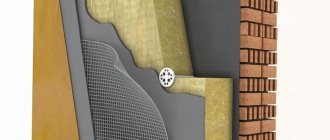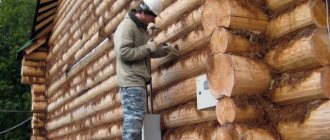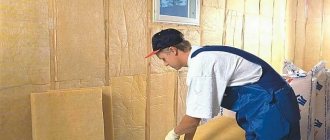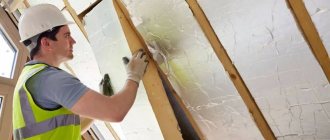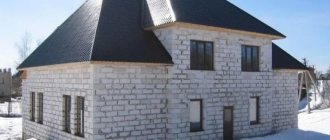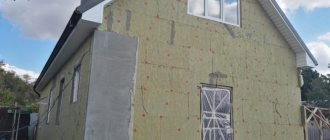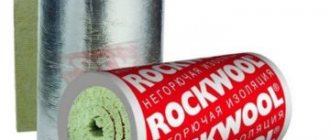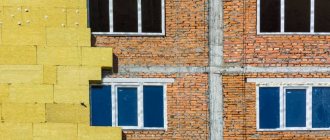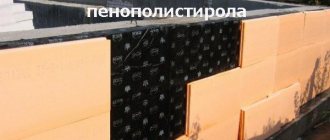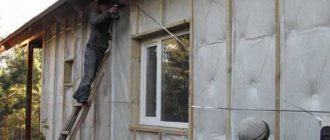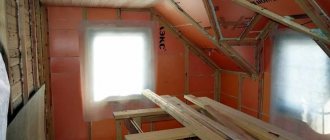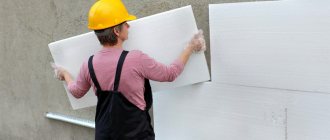Issues discussed in the material:
- The need to insulate external walls
- Why is it better to insulate walls from the outside rather than from the inside?
- Main types of materials for external wall insulation
- Recommendations for choosing insulation for the walls of a house
- 3 ways to insulate the walls of a house outside
- Technology for insulating the outside of a house with mineral wool
- The nuances of insulating the outside of a house with foam plastic
- Advantages of insulating the outside walls of a private house with bulk insulation
- Calculation of insulation thickness
- 3 factors influencing the insulation of the outside walls of a house
Insulating the walls of a house from the outside is a standard finishing procedure at the last stage of construction. There are many types of materials that are used for external insulation. The choice of one or another insulation depends on the weather conditions of the region and the operational characteristics of the housing.
For each material, its own technology has been developed, taking into account the characteristics of the insulation. How to choose the right material for external wall insulation and what needs to be taken into account when carrying out this type of work, read on.
The need to insulate external walls
In any building, heat loss largely occurs through the walls. The quantitative indicator depends on the material and thickness of the structure, and the presence of cracks in it. But on average, walls transmit up to 40% of heat. With rising energy prices, the issue of saving energy is becoming more and more urgent, and therefore, it is necessary to think about insulating the walls of the house from the outside.
By completing this work, you will receive the following benefits:
- a layer of insulation placed outside does not reduce the usable space inside the house;
- the load on supporting structures does not increase;
- a layer of insulation mounted on the outside additionally protects the walls, thereby increasing their service life. The outer cladding performs a decorative function;
- external installation of insulation, in contrast to internal installation, ensures optimal vapor exchange between the walls and the environment, due to which moisture does not accumulate in the heat-insulating material, and the walls do not freeze;
- The soundproofing properties of the structure are increased.
Proper insulation of the outside walls of a house significantly increases the energy efficiency of the building. At the same time, you can save on heating almost twice.
In principle, installation of insulation can be carried out not only from the outside, but also from the inside. But the second method is used much less frequently, as it has many disadvantages. Therefore, insulation work is usually carried out on the facade of houses.
Why is it better to insulate walls from the outside rather than from the inside?
When the insulation layer is located indoors, the outer wall experiences negative environmental influences - temperature changes, frost, ultraviolet radiation, precipitation. All this gradually destroys the material. Another serious point that must be taken into account when installing internal insulation is that the dew point penetrates into the thickness of the wall. Consequently, in cold weather condensation will constantly collect in it.
Damp walls are an excellent breeding ground for mold and fungi, which will be almost impossible to get rid of. Not to mention the fact that when installing insulation internally, you will have to sacrifice living space.
All these negative aspects are irrelevant if you insulate the walls of the house from the outside. You will save useful space in the premises, and the walls will receive additional protection from moisture, sun and extreme temperatures. At the same time, the quality of thermal insulation will be no worse.
Recommendation! When solving the issue of insulating a house, it is necessary to first consider the external installation of the material. And only in the absence of such a possibility, work is carried out indoors. It is important to perform high-quality vapor barrier.
Results
There are many materials for insulating the outside of a house. Each of them has both pros and certain cons. There are insulation materials that do their job well, but are expensive or difficult to work with.
There are more affordable materials, but they may be inferior in their useful qualities. The choice of the most appropriate option should be based on what type of surface needs to be insulated, how much the building needs thermal insulation, how long the insulation system should last, as well as the financial capabilities of the home owner.
Main types of materials for external wall insulation
Today on the market you can find many materials suitable for insulating the outside walls of a house. But only a few types are most widely used: polystyrene foam, basalt wool, glass wool, extruded polystyrene foam, mineral wool and others.
In general, simple plastering can also reduce the thermal conductivity of the wall. But the effectiveness of this method is significantly lower compared to installing a special layer of insulation. In addition, plastering work requires special skills.
Insulation of the walls of a wooden house from the outside can be done with any of the above materials (except for polystyrene foam). To do this, a double frame is mounted, the first level of which is intended for insulation, and the cladding is attached to the second. It is necessary to leave an air gap between these two layers, which ensures ventilation of the wall with insulation.
Advice from professionals
- Insulation of a private wooden house should be done only after its main shrinkage, then the heat-insulating material will not deform or deteriorate.
- Insulation for walls inside a wooden house in the countryside definitely needs to be “breathable”.
- For internal insulation of stone walls, it is necessary to use only environmentally friendly, non-combustible materials.
- The greatest efficiency in insulation can be achieved if you use seamless materials and technologies.
- When insulating the walls of a frame house, preference should be given to foamed polyurethane.
Recommendations for choosing insulation for the walls of a house
If you are new to the construction business and you do not have the opportunity to entrust the insulation of your house to an experienced craftsman who understands the characteristics of the material, then you should independently study the information about the available technologies. As a rule, the material for insulation must be selected depending on what the walls are built from and what kind of cladding is planned in the future.
Table. The choice of insulation depending on the material for wall cladding.
| Wall/façade type | Recommendations |
| Facing brick | Good ventilation is very important for this material so that the walls do not get wet. It is provided due to the air gap between the outer cladding and the wall surface. That is, the wall will be three-layer. |
| Ventilated | This is a type of curtain wall that is attached to the sheathing. It is best to use mineral wool as insulation. |
| Wooden house | Insulation of the walls of a house made of timber from the outside is carried out using curtain facade technology; the only possible heat-insulating material is mineral wool. |
| Wet | Possible materials for insulation are mineral wool and, less commonly, expanded polystyrene. This technology also requires a ventilation gap. |
Insulation of the outside walls of a house can be carried out in two or three layers. When choosing the appropriate option, you should focus on regulatory documents. It must be taken into account that the finishing with panels or plaster is not an independent layer. If three-layer insulation is made, then the outer layer is made of structural material.
Advice! Despite the large selection of insulating materials, the best options are mineral wool and expanded polystyrene.
Plaster mixtures
A less popular method of insulating house facades is the use of insulating plaster mixtures. This is a cement-based building mixture with various additives. There are two types of such plasters: vermiculite and polystyrene foam. The former are usually used to insulate a building from the inside. They have high chemical and biological stability.
Heat-insulating plaster is applied in the same way as classic plaster, using a spatula. It is not necessary to level the walls. After applying the insulation, the surface is primed and decorative plaster is applied.
The advantages of this method of insulation are the high vapor permeability of the heat-insulating layer, environmental safety, and good adhesion of the plaster to the surface. The main disadvantage is the high cost of the material.
Technology for insulating the outside of a house with mineral wool
Mineral wool is the most popular material for insulating the exterior walls of a house; it is used for buildings for various purposes.
The material has many advantages:
- non-hygroscopic;
- does not contain toxic impurities;
- does not burn;
- does not deform during operation;
- passes steam well;
- is a sound insulator;
- chemically inert;
- can be used in any climate.
Mineral wool is available in one of three types: slag wool, glass wool and stone (or basalt). Each type of material has its own characteristics.
If we talk about residential buildings, it is best to insulate the outside walls of the house with stone wool. This is the strongest and most durable material, and it is also safer than glass wool. Basalt wool has one drawback - it is expensive.
Glass wool made using modern technologies is not at all the same material that was produced ten years ago. This insulation is safe for the respiratory tract and is suitable for insulating the walls of a house both outside and inside. Glass wool can also be used to insulate floors.
The material is available in the form of individual slabs or in rolls. It weighs little and is easy to install. If you need to insulate a large surface, then it is more convenient to use rolls, while for limited areas individual slabs are better suited.
Roll material is usually cheaper than slab material. Glass wool in rolls is easily cut with a simple knife.
The disadvantages of glass wool include the following:
- when working with the material, you need to protect the skin of your hands and eyes - wear gloves and goggles;
- the material consists of fragile fibers, as a result of which small particles inevitably enter the air during installation. This means you need to work in a respirator.
Although modern glass wool is not comparable with previously produced material, nevertheless, during installation it will still be necessary to protect people’s respiratory organs from the resulting dust.
The nuances of insulating the outside of a house with foam plastic
Expanded polystyrene, or polystyrene foam, is a very popular material for insulating the outside walls of a brick house. It is lightweight and inexpensive.
There are two types of foam - individual granules and slabs. The ability to retain heat directly depends on the density of the material. The thermal insulation properties of polystyrene foam are achieved due to the air contained in its porous structure.
Among the positive characteristics of expanded polystyrene are ease of installation, low flammability of some of its brands, and wide availability. It also does not absorb moisture at all. The strength of polystyrene foam is quite sufficient to use it as a material for insulating the outside walls of a house.
Important! Polystyrene foam may be flammable or contain fire retardants. The first type, when exposed to fire, releases toxic substances. It is impossible to distinguish the materials by appearance, therefore polystyrene foam is used only for external insulation.
Also among the advantages of polystyrene foam are its following properties:
- good ability to retain heat;
- cheapness;
- long service life.
One of the disadvantages is its inability to transmit water vapor. That is why polystyrene foam cannot be used to insulate the walls of a log house from the outside.
Also among the disadvantages is low mechanical strength - the material is easily damaged during installation. In addition, already installed insulation needs careful handling, since it is easily damaged by a blow to the wall.
Extruded polystyrene foam is made from the same raw materials, but thanks to a special technology, it produces a material with slightly different characteristics than conventional foam. It also does not absorb moisture, has approximately the same thermal conductivity, but is much more durable. The cost of this material is higher than simple foam. It is used for thermal insulation of the lower part of the house - the basement, foundation.
The production technology of extruded polystyrene foam makes it possible to obtain a material with the following properties:
- high compressive strength;
- low moisture absorption;
- low flammability, some brands contain enough fire retardant to resist fire 100%;
- reduced thermal conductivity.
Expanded polystyrene is characterized by greater strength and reliability, will last longer compared to conventional foam, but is also more expensive.
The material slabs have a smooth surface, which creates difficulties during installation. This is also a certain disadvantage, because to ensure normal adhesion of polystyrene foam and the adhesive composition, the slabs have to be additionally processed. This is especially important when using wet facade insulation technology.
A smooth surface needs to be given a rough texture using sandpaper. As an additional measure, an adhesive primer is used, which allows the adhesive to penetrate deep into the material.
Insulation of the outside walls of a house with all types of polystyrene foam is carried out using the same technology. First, the surface of the walls is cleaned of dirt and leveled. Then foam plastic boards are glued onto it, which must first be roughened with sandpaper. The compositions for this operation must be suitable for polystyrene foam. For more secure fixation, you can use umbrella nails. A finishing layer is installed on top of the insulation - plaster or other facing material at the choice of the home owner. Sometimes the insulation needs to be secured with reinforcing mesh.
There is another method of fixing the material on the walls - using wooden lathing. It is made of slats, the thickness of which should match the thickness of the insulation or be slightly larger. In the latter case, there will be an air gap under the outer skin for ventilation. The slats are attached to the wall in increments equal to the width of the insulation sheets.
Recommendation! The lathing made in this way can serve as the basis for attaching not only the insulation, but also the outer finishing layer.
Advantages of insulating the outside walls of a private house with bulk insulation
Insulation of the walls of a house from the outside can be done not only with slab materials, but also with bulk materials.
The most commonly used materials are:
- vermiculite;
- perlite crushed stone;
- expanded clay
Vermiculite is suitable for making thermal insulation of building walls from the outside and inside, as well as for insulating water supply and sewerage pipes, floors and attics, and foundations. The material can be either bulk or slab. Vermiculite is also used as a filler for cement mortars.
This is an environmentally friendly material of natural origin, which does not contain harmful substances. Vermiculite has the following advantages: low thermal conductivity, non-flammability, ability to absorb sounds, long service life. In addition, it is lightweight and non-hygroscopic.
To insulate the outside walls of a house, vermiculite is used in two ways. First: the material is added to the cement mortar, thereby reducing its thermal conductivity. Second: they build a decorative wall around the perimeter of the building and pour vermiculite between it and the main wall. This is an expensive method, because erecting a decorative wall creates additional load on the foundation, so you need to build a base underneath it; usually, facing bricks are used for this.
The low weight of vermiculite is also convenient because its delivery does not require special transport. Usually the material is packaged in 25 kg bags, which can be transported by car.
Perlite is a volcanic rock that is used not only in construction, but also in other industries (for example, metallurgy) and agriculture. The material is produced in the form of granules of various sizes and is used to insulate roofs and floors of buildings.
Positive properties of perlite:
- porous structure;
- cheapness;
- high hygroscopicity, which does not affect other properties;
- non-flammability;
- low thermal conductivity.
The thermal insulation properties of a 3 cm layer of perlite are similar to a 25 cm thick brick wall.
Expanded clay is made from special clay, to which some other components (peat, sawdust, solar oil, etc.) are sometimes added to increase porosity, by firing in special ovens. The result is porous granules of various fractions - from 2 to 40 mm.
Expanded clay of a fraction from 10 to 20 mm is suitable for insulating the walls of a house from the outside (this is the most popular granule size). It is poured between the main wall and the decorative one.
An expanded clay layer 10 cm thick has the same thermal conductivity as a brick layer 1 m thick. If expanded clay is used as insulation for a house, the building will retain heat for a long time in winter and cool in summer.
Advantages of expanded clay as an insulating material:
- cheapness;
- the energy efficiency of a building insulated with expanded clay increases to 75%;
- operation is allowed at any temperature and humidity;
- long service life;
- does not rot and does not burn;
- not damaged by insects and rodents;
- simple installation that does not require special skills or tools.
Extruded polystyrene foam
Extrusion is a synthetic insulation material. It is based on a unique technology developed in the USA. The quality of the insulation is so high that many of the best construction companies give it preference in all areas of construction.
Advantages of extruded polystyrene foam:
- Thermal conductivity is extremely low.
- Vapor permeability is insignificant. In comparison, a 20 mm slab has the same level of vapor permeability as 1 layer of roofing felt.
- Resistant to mechanical deforming influences.
- It tolerates a wide temperature range from -50 to +75°C.
- The material is durable, service life is 30 years or more.
- Completely environmentally friendly, does not emit harmful substances during operation.
- When wet, it does not lose its quality characteristics, which is very important in roof insulation.
- Installation is as simple as possible.
There are practically no disadvantages with external and internal insulation. The main factor is flammability, but this can be eliminated by adding fire retardants to the composition, although such boards are somewhat more expensive. In this case, it will only smolder, but the release of harmful substances is still dangerous to health.
Calculation of insulation thickness
How to determine how thick a layer of insulation is required to achieve the optimal level of thermal insulation for a home? This issue actually requires increased attention, because a mistake of just a couple of centimeters can turn into problems that will require serious investment to correct.
The thickness of the insulation is calculated taking into account the quality of the material and its technical characteristics. Of particular importance are:
- heat transfer resistance coefficient;
- thermal conductivity.
These indicators characterize the amount of heat passing through m² of material surface.
Sometimes it is necessary to lay insulation in several layers. In this case, the overall indicators of the “pie” will be the sum of the individual values of each layer. It is also necessary to take into account what material the walls themselves are made of.
The climatic characteristics of the region are also included in the calculations. It is clear that the insulation of the exterior walls of a house will be different for the north of Siberia and the Krasnodar Territory.
Calculations are carried out on the basis of standard parameters given in SNiP 02/23/2003 “Thermal protection of buildings” and 01/23/99 “Climatology”. The first document contains background information regarding the heat transfer coefficients of building envelopes (R0), and from the second you can find out the temperature values and the duration of the heating season in the region.
The next step is to determine the parameters of the building's structural elements. You need to find out what materials the walls, floor, and attic ceiling are made of. For example, a house on stilts may have a three-layer floor:
- the lower part of the support beams is hemmed with boards;
- then a layer of insulation is installed;
- Boards are attached on top of the beams, on which the finished floor is then laid.
In this case, it will be necessary to take into account the thermal conductivity (λ1) of each layer.
Then the thermal resistance of the main building material (R1) should be calculated taking into account its thickness (δ1) in meters.
The calculation is performed using the formula:
R1 = δ1 / λ1.
Then you need to find out by what amount you want to increase the thermal resistance (R2) of the structure due to insulation:
R2 = R0 - R1.
Now you can proceed directly to determining the required insulation thickness (δ2). To do this, you need to multiply the resulting value of the missing resistance R2 by the value of thermal conductivity λ2 of the material that you want to use for insulation:
δ2 = R2 * λ2.
The resulting value will be the thickness of the insulation in meters. All roundings of the calculated value are made upward.
